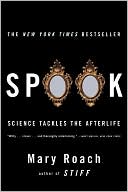 Author: Roach, Mary
Author: Roach, Mary
Publisher: W. W. Norton
Year Published: 2005
Rating: 
Buy from Amazon.com
In Stiff: The Curious Lives of Human Cadavers, Mary Roach gave a humorous summary of what happens to our bodies when we die. Spook: Science Tackles the Afterlife looks beyond the physical for proof that a part of us survives death.
Roach approaches the material as a skeptic who wants to believe but needs the proof. As she says in the opening pages
Simply put, this is a book for people who would like very much to believe in a soul and in an afterlife for it to hang around in, but who have trouble accepting these things on faith.
In Spook, Roach isn’t afraid to tackle even the most bizarre phenomenon. She admits to knowing next to nothing about her subjects when she first starts, so anything is fair game – from traveling to India to see claims of reincarnation first hand to taking a seminar to learn to become a psychic, from talking with scientists studying near-death experiences to digging up props that were once spewed as ectoplasm by spiritualists.
No detail seems too small for Roach. When looking for the soul, for instance, she goes in search of the legendary luz of Jewish Midrash – a single indestructible bone in the spine from which a person is reconstructed after death; talks of Antoni van Leeuwenhoek’s observations of sperm under the microscope, which led to the erroneous notion of preformationism – the idea that tiny embryo live in the heads of sperm; and discusses Duncan Macdougall’s attempts to weigh the body at the time of death and who famously declared that the soul weighs 21 grams.
Roach writes with a clever, witty style reminiscent to Stiff. She takes a hands on approach, immersing herself in the material, talking with prominent scientists who are studying this phenomenon, and even venturing out into the fringes of paranormal studies to see what other explanations are available.
Unfortunately, that’s also the book’s downfall. Roach seems more concerned with writing witty, entertaining prose than separating the legitimate scientific studies from the pseudoscience. She’d prefer to throw it all out there and let the reader piece together the sound evidence rather than stick with the premise she started – to see what proof science has found for an afterlife.
Surprisingly, Roach also missed what I think is one of the strongest long-term studies out there supporting reincarnation. Ian Stevenson started collecting a database of over 2500 children who claim to remember past lives at the University of Virginia in Charlottesville. Jim Tucker has been continuing his research. Some of the stories these kids tell are incredible – from children who pick up the mannerisms and even scars and injuries from their previous personalities to those that remember specific experiences and personal details that would be virtually impossible for a child to know. Check out Tucker’s fascinating Life Before Life: A Scientific Investigation of Children’s Memories of Previous Lives for more information.
Spook is an incredibly entertaining read and difficult to put down but if you’re looking for concrete proof that there’s an afterlife, you won’t find it here. What you’ll get are lots of interesting trivia, entertaining stories, and bits and pieces of possible evidence.